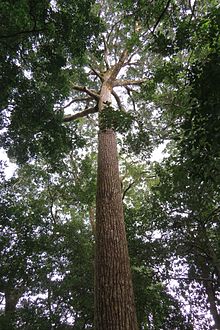| Calophyllum polyanthum | |
|---|---|

| |
| Punnapine, in sabarimala | |
| Scientific classification | |
| Kingdom: | Plantae |
| Clade: | Tracheophytes |
| Clade: | Angiosperms |
| Clade: | Eudicots |
| Clade: | Rosids |
| Order: | Malpighiales |
| Family: | Calophyllaceae |
| Genus: | Calophyllum |
| Species: | C. polyanthum
|
| Binomial name | |
| Calophyllum polyanthum | |
| Synonyms[1] | |
| |
Calophyllum polyanthum is a species of flowering plant belonging to the genus Calophyllum of the family Calophyllaceae, commonly known as the poonspar tree, sirpoon tree, punnapine, pinnapai, punnappine, kattupunna and malampunna. This tree is native to the Western Ghats in India (Assam, Barak Valley, and Kerala), where it grows in abundance there. It is also found in Andaman & Nicobar Island, Bangladesh, Bhutan, Laos, Myanmar, Thailand and Vietnam.[2]
Description[edit]
Calophyllum polyanthum are tall trees with many branches, growing up to 45 m tall. The wood is very tough and the bark color ranges from grey to brown. Outer bark is yellowish, with strong. Stems are branches and branchlets quadrangular, glabrous. The leaves are simple, opposite, decussate; petiole 0.8-2.5 cm long, narrowly margined. It bears white flowers, which are fragrant and in panicles. The seed is a drupe, ellipsoid, apiculate, 3.7 cm long, one-seeded. Fruits are yellow and dark purple at maturity, and the flowering/fruiting season is from June to September.[3][4]
Uses[edit]
The wood is used in construction, paper pulp, and furniture making.[2] The timber is also used for making tea chests, tent poles, mathematical instruments, construction of ghat roads particularly leading to the sea coast. Seeds are used for illuminating purpose. Fruits are edible. Wood is anti-termitic.[3]
Diseases[edit]
Calophyllum species are susceptible to various insect pests, virus and fungi, affecting leaves, fruits and roots.
References[edit]
- ^ "Calophyllum polyanthum Wall. ex Planch. & Triana — The Plant List". www.theplantlist.org. Retrieved 2019-01-14.
- ^ a b "Calophyllum polyanthum - Useful Tropical Plants". tropical.theferns.info. Retrieved 2019-01-14.
- ^ a b "Calophyllum polyanthum Wall. ex Choisy". India Biodiversity Portal. Retrieved 2019-01-14.
 This article contains quotations from this source, which is available under the Creative Commons Attribution 3.0 Unported (CC BY 3.0) license.
This article contains quotations from this source, which is available under the Creative Commons Attribution 3.0 Unported (CC BY 3.0) license.
- ^ "Calophyllum polyanthum - CLUSIACEAE". www.biotik.org. Retrieved 2019-01-14.